
Future Tech: Researchers Makes LED Displays Inherently Interactive, And Solar Collectors
April 18, 2024 by Dave Haynes
As spotted in Display Daily, which is paywalled.
One of the minor knocks against using LED display for video walls was how they did not support touchscreen interactivity, because the displays with micro-soldered light emitters were fragile and really not meant to be touched. It didn’t matter much because LED video walls didn’t tend to have sufficiently tight pixel pitches that would encourage up-close usage.
Now sub 1mm pixel pitches are common and those LED displays can look crisp even when people are up close, and new manufacturing techniques addd protective layers that make them OK to touch. We’re starting to see LED-based video walls that are interactive in much the same way as LCD video walls.
I note this because a very technical piece in Display Daily references researchers from university labs in China and Sweden who have developed a version of LED displays that function as screens, but can also be interactive and even act as solar collectors, so they could in theory self-charge.
The LEDs are made from the mineral perovskite, which is particularly good at light absorption and is the subject of a lot of R&D work for solar energy applications.
The research abstract says:
We have reported a multifunctional display based on photo-responsive PeLEDs. The display can work as a touch screen, ambient light sensor and image sensor (including fingerprint drawing, which indicates promise as a fingerprint sensor). Such integration of different functions could be used to simplify the structure and decrease the cost of display modules, and could allow ultra-thin and light-weight displays to be created. Moreover, the high photoresponsivity of the pixels makes the display screen a potential platform for human–machine interactions. For example, we show that the screens can be used as a scanner, a PPG sensor and to charge a supercapacitor. Our results illustrate the unique advantages of PeLEDs for display applications and offer a promising route for the development of ultra-thin, multifunctional displays.
From Display Daily …
The research team has successfully developed PeLEDs in red, green, and blue, essential for creating a full-color display. However, challenges such as improving the service life of PeLEDs remain, with current screens functioning for only a few hours before material instability occurs.
The researchers are optimistic that these issues will be resolved within the next decade, paving the way for this technology to become commercially viable.
PeLEDs stand out for their potential in creating high-quality displays characterized by high color purity, efficiency, brightness, and compatibility with various deposition processes. Their high optical absorption and superior carrier transport properties make them ideal for developing photo-responsive LEDs. This key feature is exploited to merge multiple sensor functions directly within the display pixels, thus eliminating the need for integrating additional sensors.
The result is a display capable of performing as a touch screen, ambient light sensor, and image sensor, including fingerprint recognition, through the photo-responsive capabilities of the PeLEDs that enable detection of light excitation and efficient conversion of light to electricity.
As stated a couple of paragraphs back, this is all R&D stuff and commercial viability might be a decade off. The diagrams also suggest smartphone screens, not digital OOH billboards. But it’s interesting to think long-term about display tech that conceivably powers itself, and is inherently interactive.



What a great idea!